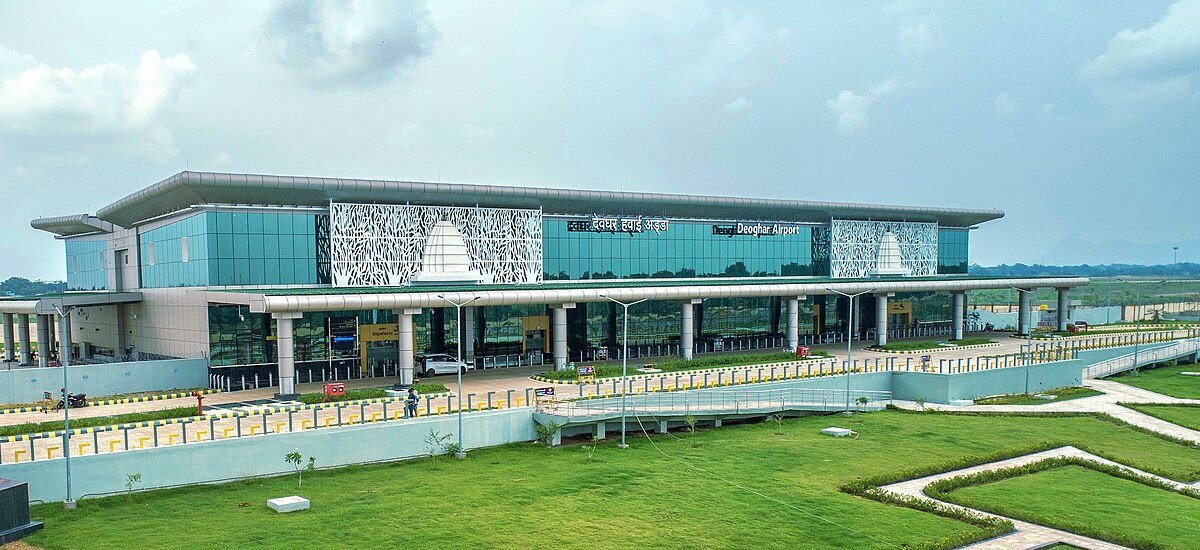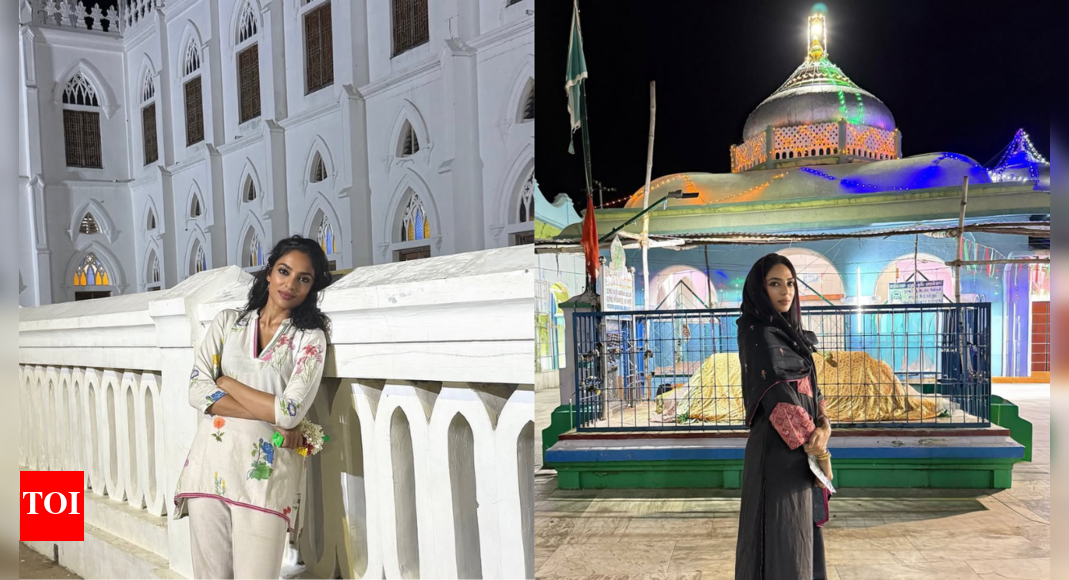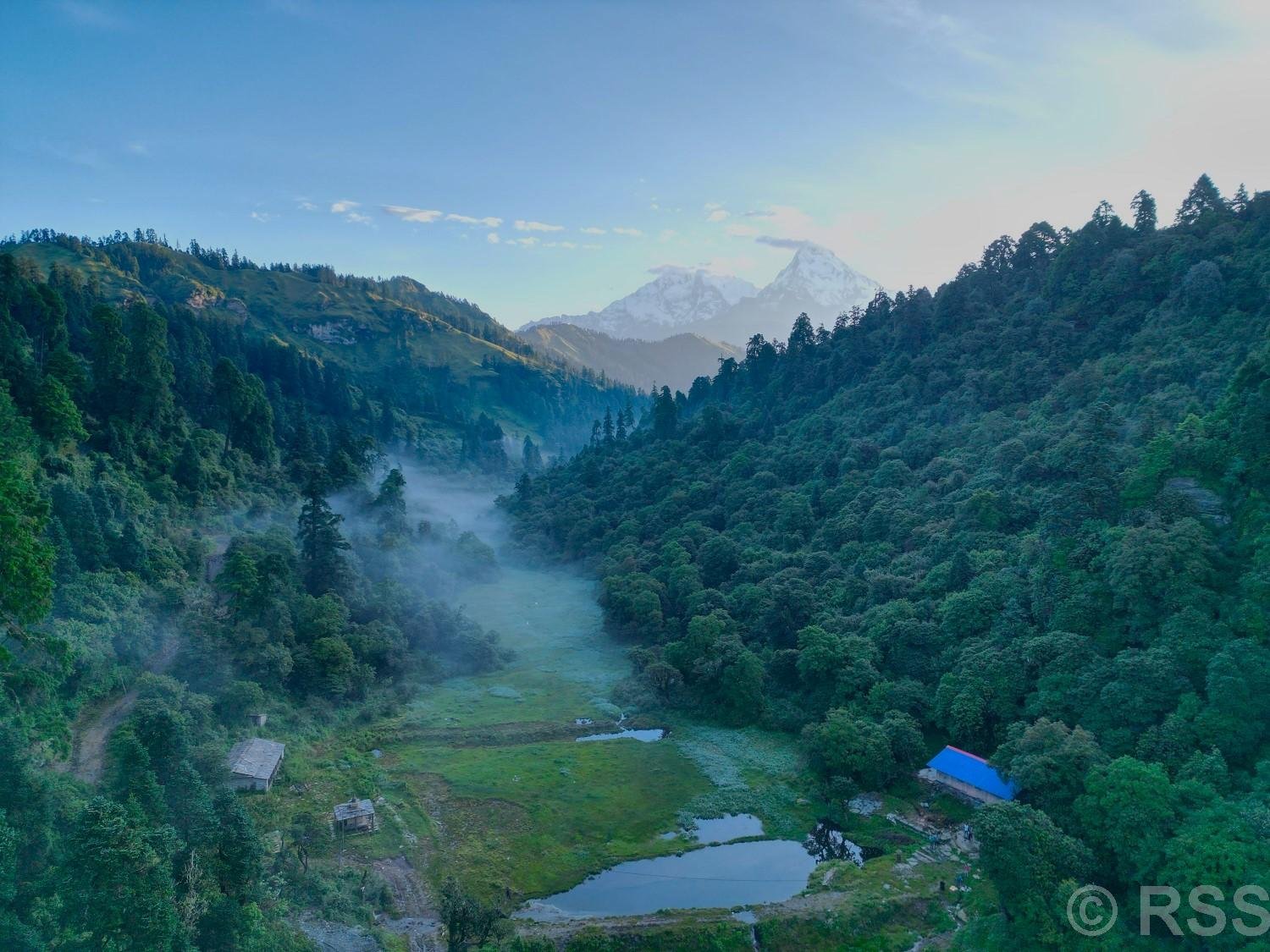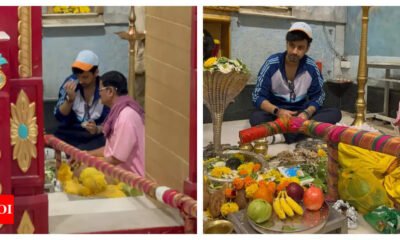Spiritual Travel
Blending Spiritual Heritage with Modern Aviation

In the heart of Jharkhand, a remarkable aviation project is taking shape that represents more than just modern infrastructure – it’s a testament to India’s ability to harmonize ancient spiritual heritage with contemporary design. Deoghar Airport, nestled in the sacred town of Deoghar, is emerging as a unique architectural marvel that pays homage to one of Hinduism’s most revered pilgrimage sites while serving the practical needs of modern air travel.
The Sacred Setting: Deoghar’s Spiritual Significance
Deoghar, literally meaning “abode of the gods,” holds an unparalleled position in Hindu spirituality. The town is home to the Baba Baidyanath Temple, one of the twelve sacred Jyotirlingas dedicated to Lord Shiva, making it a destination of profound religious importance. This sacred site uniquely represents both a Jyotirlinga and one of the 51 Shakti Peethas, creating a rare confluence of Shiva and Shakti worship.
The temple complex, steeped in millennia of devotion, attracts millions of pilgrims annually, particularly during the Shravan month when the famous Kanwar Yatra brings devotees from across the subcontinent. According to religious tradition, the temple was built by Vishwakarma, the divine architect of the gods, adding to its mythological significance and architectural importance.
This spiritual backdrop has profoundly influenced the design philosophy of Deoghar Airport, creating a unique opportunity to celebrate local heritage while facilitating modern connectivity.
Architectural Inspiration: Temple-Inspired Design
Drawing from Divine Architecture
The most striking feature of Deoghar Airport is its terminal building design, which draws direct inspiration from the structure of the Baba Baidyanath Temple. This architectural homage represents a thoughtful approach to airport design that respects and celebrates local identity rather than imposing generic modernist structures.
The terminal’s facade echoes the temple’s distinctive silhouette, with carefully crafted elements that mirror the sacred architecture’s proportions and aesthetic principles. This design choice ensures that visitors arriving at Deoghar immediately understand they have reached a place of profound spiritual significance.
Scale and Scope
Spread across a vast area of 650 acres, the airport represents a significant infrastructure investment in the region. The generous land allocation allows for both current operational needs and future expansion, while providing space for the architectural elements that celebrate local culture.
Cultural Integration: Art, Craft, and Heritage
Showcasing Local Artistry
The terminal building serves as a canvas for local tribal art, featuring paintings, handicrafts, and images of regional tourist destinations. This integration of local artistry transforms the airport from a mere transit point into a cultural exhibition space, offering travelers an immediate immersion into Jharkhand’s rich artistic traditions.
The inclusion of tribal art is particularly significant, as it acknowledges and celebrates the indigenous communities of the region, whose artistic traditions have often been overlooked in major infrastructure projects. By prominently featuring these works, Deoghar Airport becomes a platform for cultural preservation and promotion.
Tourist Destination Highlights
The interiors prominently display pictures and artistic representations of local tourist destinations, highlighting the cultural richness of the region. This approach serves dual purposes: educating visitors about local attractions while potentially boosting regional tourism by creating awareness of destinations beyond the primary spiritual sites.
Modern Facilities Within Traditional Aesthetics
Balancing Function and Heritage
Despite its traditional aesthetic inspiration, the terminal is equipped with modern, state-of-the-art passenger facilities. This balance between heritage design and contemporary functionality represents the best of both worlds – passengers enjoy modern conveniences while experiencing a uniquely cultural environment.
The challenge of maintaining operational efficiency while incorporating cultural elements has been addressed through careful planning and design integration. Modern amenities, security systems, and passenger flow management are seamlessly incorporated within the culturally-inspired framework.
Environmental Considerations
The airport features an environment-friendly architectural design, reflecting contemporary concerns about sustainability. This commitment to environmental responsibility aligns with traditional Indian architectural principles that emphasized harmony with nature, creating a structure that honors both ancient wisdom and modern environmental consciousness.
Strategic Connectivity: Serving Pilgrims and Progress
Regional Connectivity Enhancement
Under the Government’s Regional Connectivity Scheme (UDAN), IndiGo has been selected to operate flights from Deoghar to Ranchi, Kolkata, and Patna. This connectivity enhancement will significantly improve accessibility for the millions of pilgrims who visit annually, reducing travel time and increasing convenience.
The routes chosen reflect practical connectivity needs, linking Deoghar to state capitals and major urban centers, thereby facilitating both religious tourism and business travel. This strategic approach ensures the airport’s viability while serving its primary purpose of enhancing pilgrimage accessibility.
Economic Impact
The airport’s development represents more than infrastructure improvement; it’s an economic catalyst for the region. Enhanced connectivity will boost local businesses, create employment opportunities, and potentially attract investment in hospitality and service sectors. The cultural integration aspect may also position Deoghar as a unique destination, differentiating it from other regional airports.
Construction Progress and Future Prospects
Development Timeline
Construction activities are expected to commence in late 2025, marking the beginning of a transformative phase for regional connectivity. The timeline reflects careful planning and preparation, ensuring that the final product meets both operational requirements and cultural aspirations.
Broader Implications for Indian Aviation
Deoghar Airport’s culturally-integrated design represents a potential model for future airport development in India. Rather than adopting generic international airport aesthetics, this approach demonstrates how aviation infrastructure can celebrate local identity while maintaining world-class functionality.
The project challenges the conventional wisdom that modernization requires cultural compromise, instead showing how thoughtful design can enhance both functionality and cultural value.
Challenges and Considerations
Balancing Tradition and Technology
The integration of traditional design elements with modern aviation requirements presents ongoing challenges. Issues such as maintenance of cultural displays, preservation of artistic elements, and ensuring that heritage features don’t compromise operational efficiency require continuous attention.
Managing Increased Visitor Flow
The airport’s success in improving connectivity may lead to increased tourist and pilgrim volumes, requiring careful management to prevent overcrowding at religious sites and ensure sustainable tourism development.
Bottomline : A New Paradigm for Aviation Architecture
Deoghar Airport stands as a pioneering example of how modern infrastructure can honor and celebrate local heritage. By drawing inspiration from the sacred Baba Baidyanath Temple and incorporating local artistic traditions, the airport creates a unique identity that serves both practical and cultural purposes.
This approach offers valuable lessons for future aviation projects across India and beyond. It demonstrates that airports can be more than functional transit points – they can be cultural ambassadors, educational spaces, and celebrations of local identity. As Deoghar Airport prepares for completion, it represents not just improved connectivity for a sacred destination, but a new paradigm for culturally-conscious infrastructure development.
The project embodies the best of Indian aviation’s future: technologically advanced, culturally rooted, and spiritually aware. When completed, Deoghar Airport will serve as a gateway not just to a destination, but to an experience that honors the past while embracing the future.
Spiritual Travel
Sobhita Dhulipala visits Velankanni Church and Nagore Dargah during spiritual trip to Tamil Nadu – Watch |

Actor Sobhita Dhulipala recently shared some pictures of her spiritual getaway in Tamil Nadu. The ‘Made in Heaven’ star took to Instagram on Thursday to share glimpses from her serene trip, which included visits to the iconic Velankanni Church and Nagore Dargah.
At Velankanni Church and Nagore Dargah
The actor shared photographs of her travels in her post with the title of “Life lately.” In these images, Sobhita was seen in a white outfit praying at the Velankanni Church, known formally as “The Basilica of Our Lady of Good Health”. The church is one of India’s most frequented Catholic shrines.Sobhita also visited the Nagore Dargah, a prominent Sufi shrine in Tamil Nadu located in the coastal town of Nagore. For this visit, she wore a black outfit, which complemented the modesty of the Dargah as well as fit with the overall spiritual tone of the site. The Dargah is the final resting place of the Sufi saint Nagore Syed Abdul Qadir Shahul Hamid.
Enjoying the beach
Sobhita also shared pictures of herself enjoying some peaceful moments at the beach as the waves washed over her feet. One photo shows her, with a calm expression on her face, relishing the sun and the joy of the moment. Another photo shows her feeling completely joyful alone. She also shared a photo looking beautiful in a gold saree from a friend’s wedding.On the work front, Sobhita was last seen in ‘Monkey Man’, Dev Patel’s directorial debut, which did not see a theatrical release in India. She also starred in ‘Love, Sitara’, but has remained quiet about her upcoming projects.Sobhita made headlines last year after she got married to Telugu star Nag Chaitanya after a long rumoured relationship.
Spiritual Travel
Jaljala holds potential for religious tourism but remains neglected « Khabarhub

Jaljala area in Myagdi/RSS
MYAGDI: Jaljala, located at the tri-junction of Myagdi, Parbat, and Kaski districts, holds significant religious and tourism potential but remains largely neglected due to lack of infrastructure and promotion.
The Jaljala area, spanning Modi Rural Municipality in Parbat and Annapurna Rural Municipality in Myagdi, is referred to in Hindu scriptures as Hampal, Kalanjar, and Mrigasthali. Despite its religious importance, the area suffers from underdevelopment and poor accessibility.
According to cultural and heritage expert Prof. Dr. Jagannath Regmi, Hindu scriptures including Agni, Garuda, Kurma, Baraha, Skanda, Shivamaha, Padma, Brihannaradiya, Linga, Matsya Puranas, the Mahabharata, and the Shrimad Bhagavatam mention Hampal and Kalanjar.
“Despite being praised in sacred texts, Kalanjar—highlighted by Muktakantha in mythological literature—remains underdeveloped due to lack of publicity, remoteness, limited road access, and the absence of documented materials beyond oral traditions and natural and cultural sources,” said Regmi.
He noted that some ancient temples, shelters, and caves in the area are now at risk of disappearing due to a lack of protection. Religious texts claim that sages once performed penance in the Jaljala region, using its herbs for medicine, gaining spiritual insights, and offering Pinda (ancestral offerings) to attain salvation.
Tika Pun of Lespar, Modi Rural Municipality-4, who operates a small restaurant in Jaljala, said that due to limited awareness of the site’s religious and scenic value, tourist and pilgrim numbers remain low.
“Visitors mainly arrive during Mahayagyas held in autumn and spring. Otherwise, the place remains deserted,” he added.
Situated at an altitude of 3,300 meters, Jaljala features a gorge surrounded by breathtaking views of the Annapurna range. Just two decades ago, locals from Jaljala and Modi Rural Municipality used to graze cattle here during the monsoon, a practice that has since vanished.
From Jaljala, a 10-minute walk to Wi-Fi Hill offers views of Annapurna, while a 30-minute hike to Mateko Lake reveals panoramic views of Dhaulagiri, Annapurna, and Machhapuchhre.
According to Govinda Sharma, a visitor from Kushma, the scenic beauty of the region and surrounding settlements makes the challenging journey worthwhile.
Jaljala is also rich in biodiversity. Medicinal herbs such as bojo, satuwa, chiraito, amilo, brahmi (bholatapre), pashanbhed, jethimadhu, padamchalnu, niramasi, jatamasi, timmur, and siltimmur are found here. Wildlife sightings include deer along the banks and birds like vultures, cuckoos, and owls.
The region is accessible by trekking routes from Ghodepani, Pun Hill, Mohare Danda, Nagi (in Myagdi), and Modi Rural Municipality in Parbat. A dirt road connects Jaljala to Lekphant and Shalija in Jaljala Rural Municipality, according to Vice-Chairman Deepak Acharya.
“A grand yagya was organized to highlight Jaljala’s religious significance, and electricity has now been extended to the area,” Acharya said. “The federal government has allocated Rs 30 million for tourism infrastructure development here.” The Beni–Lekphant road has also been blacktopped recently, and further road upgrades have been requested.
Spiritual Travel
Thomas Cook India & SOTC Travel deepen focus on spiritual tourism

Thomas Cook (India) Limited, the omnichannel travel services company, and its Group Company, SOTC Travel, have announced the expansion of their spiritual portfolio across key pilgrimage destinations in India and the subcontinent, catering to both group and customized tours.
Traditionally, Indian spiritual pilgrimages have often been perceived as challenging and uncomfortable —marked by long journeys, limited connectivity and infrastructure. Recognising these challenges, Thomas Cook India & SOTC Travel have designed tours by introducing aerial darshans, guided tours, VIP access for darshans and more.
Rooted in the philosophy that ‘India is a Pilgrimage’, the tours have been designed to cater to the spiritual aspirations of a broad spectrum of travellers – from GenS (seniors) who value time-honoured traditions, multi-generational families to millennials and GenZ travellers seeking spirituality as a path to mindfulness, wellness and cultural discovery—seamlessly blending sacred journeys with unique local experiences.
Key highlights:
- A curated portfolio of 11 iconic pilgrimage sites across India’s vast geography, covering temples, shrines and sacred rivers across India and the Indian subcontinent
- Certified local tour experts who offer deep insights into the history and cultural significance of each site, while facilitating seamless access and VIP/escorted darshans at key pilgrimage locations
- Special aartis, pujas and spiritual rituals conducted with accompanying pandits for a personalized spiritual experience
- Pure Vegetarian/Jain meal options to align with travellers’ religious and dietary preferences
- Premium aerial darshans (via helicopters) at select pilgrimage sites for faster, more comfortable access to remote & high-altitude spiritual circuits
Top group tour pilgrimage circuits
- Char Dham Yatra (Yamunotri, Gangotri, Kedarnath, Badrinath) — The Himalayan spiritual circuit of great reverence via aerial darshans
- Kailash Mansarovar Yatra — A sacred journey to the abode of Lord Shiva via aerial darshans
- Kashi Prayagraj Ayodhya Bodh Gaya Yatra — Sacred sites along the river Ganga, steeped in mythology and history, rites and rituals.
- Dwarka Somnath Yatra — Gujarat’s twin pilgrimages celebrating Lord Krishna and Lord Shiva
- Tirupati to Trivandrum — South India’s iconic temple circuits for spiritual fulfilment
- Haridwar Rishikesh Yatra — Spiritual wellness on the banks of the Ganges
- Ujjain Omkareshwar to Bhimashankar Grishneshwar Yatra — sacred Shiva circuits in Malwa region of Madhya Pradesh to Maharashtra
- Kashi to Kathmandu To Muktinath To Janakpur – Bharat Nepāl Mahayātrā covering spiritual landmarks across both nations
- Puri Jagannath Yatra – a cornerstone of India’s Char Dham circuit and key spiritual landmark in Odisha
- Ramayan Yatras Covering India, Sri Lanka and Nepal
- Short Getaways to Vaishno Devi, Amritsar, Shirdi, Rishikesh, Mathura, Velankanni, etc.
In addition, we also offer a wide range of customised pilgrimage tours tailored to individual preferences and requirements.
Rajeev Kale, President & Country Head, Holidays, MICE, Visa – Thomas Cook (India) Limited said, “Spiritual tourism is no longer limited to a season or festival – it has become a year-round experience.
“India’s vast spiritual landscape offers travellers an unparalleled opportunity to engage with its deep-rooted spiritual ethos, while also immersing themselves in the country’s rich heritage and culture.
“With an intent is to inspire not just seniors and families but also young India’s millennials, working professionals and groups of friends, we have expanded our spiritual tours at key spiritual sites coupled with unique local experiences like river-rafting and kayaking in Rishikesh, paragliding in Vaishno Devi, cuisine trails in Varanasi and Haridwar.
“This initiative strengthens our domestic and spiritual travel segment, offering travellers a meaningful way to connect with the soul of India,” Kale added.
S.D. Nandakumar, President & Country Head – Holidays and Corporate Tours, SOTC Travel Limited said, “We are witnessing strong demand for our Darshans portfolio, with destinations like Char Dham and Kailash Mansarovar ranking among the most sought-after pilgrimage sites.
“There is also significant interest in Ayodhya, Dwarka, Vaishno Devi, Tirupati, Rishikesh, Haridwar, and Ujjain. This is gaining momentum not just from India’s metro cities, but also from regional mini-metros and tier 2–3 cities.
“To enhance comfort and convenience, we have introduced premium aerial darshans to select sacred locations via helicopters.
“Furthermore, address the challenges of spiritual travel in India, we’ve curated end-to-end tours that offer our customers assurance and ease—covering transport, accommodation, VIP/escorted darshans, guides and more.
“Our meaningful TravSure assurance programme covers select pilgrimage sites ensuring a safe, smooth and hassle-free experience with comprehensive travel insurance and on-ground support,” Nandakumar added.
-

 Brand Stories3 weeks ago
Brand Stories3 weeks agoBloom Hotels: A Modern Vision of Hospitality Redefining Travel
-

 Brand Stories2 weeks ago
Brand Stories2 weeks agoCheQin.ai sets a new standard for hotel booking with its AI capabilities: empowering travellers to bargain, choose the best, and book with clarity.
-

 Destinations & Things To Do3 weeks ago
Destinations & Things To Do3 weeks agoUntouched Destinations: Stunning Hidden Gems You Must Visit
-

 Destinations & Things To Do2 weeks ago
Destinations & Things To Do2 weeks agoThis Hidden Beach in India Glows at Night-But Only in One Secret Season
-

 AI in Travel3 weeks ago
AI in Travel3 weeks agoAI Travel Revolution: Must-Have Guide to the Best Experience
-

 Brand Stories1 month ago
Brand Stories1 month agoVoice AI Startup ElevenLabs Plans to Add Hubs Around the World
-

 Brand Stories4 weeks ago
Brand Stories4 weeks agoHow Elon Musk’s rogue Grok chatbot became a cautionary AI tale
-

 Brand Stories2 weeks ago
Brand Stories2 weeks agoContactless Hospitality: Why Remote Management Technology Is Key to Seamless Guest Experiences
-

 Asia Travel Pulse1 month ago
Asia Travel Pulse1 month agoLooking For Adventure In Asia? Here Are 7 Epic Destinations You Need To Experience At Least Once – Zee News
-

 AI in Travel1 month ago
AI in Travel1 month ago‘Will AI take my job?’ A trip to a Beijing fortune-telling bar to see what lies ahead | China







You must be logged in to post a comment Login